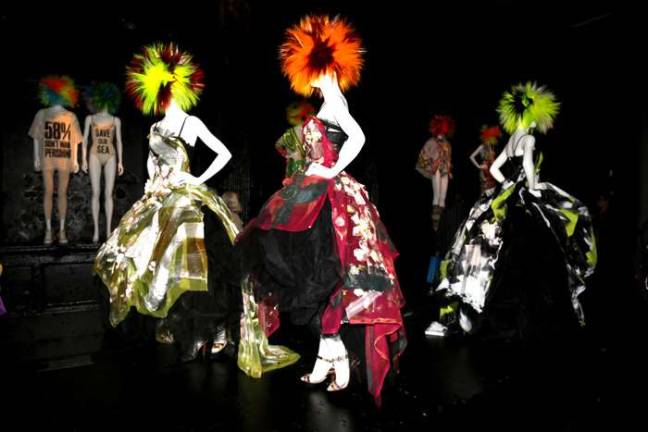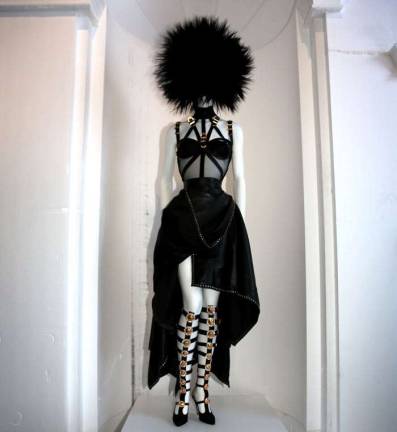Punks Jump Up


Culture warp at the Met's "Chaos to Culture" show
What punk? An extravaganza prefaced by a non-smelly replication of the club CBGB's toilet, "Punk: Chaos to Couture" is the Metropolitan Museums of Art's most recent nod to what used to be termed popular culture. Here, go directly to couture despite some mood-inducing references, in piped-in time-appropriate music and paraphernalia. On opening day there was none of the whiff of rubber either, promised by some promotional bits, though many looks of wonderment from a crowd who had missed it all, taking forbidden pictures - perhaps the only spontaneous expression of authority-challenging at hand.
The exhibit credits an admitted re-colonizer, Brit rock promoter Malcolm McLaren, for packaging punk, quoting him as saying he was first inspired by Richard Hell of the Voidoids when catching his act at CBGB's on the lower east side at 315 Bowery. Taking home to England the look of spiky hair, sloganned and ripped T-shirts and of course attitude, he and then-inamorata Vivienne Westwood, now a high end designer, showcased and sold punk-inspired designs in their store Seditionaries at 430 King's Road in London. The first room of this show's seven is titled "A Tale of Two Cities."
That's pretty much it for the American side of things, with club-goers described as middle-class kids with dyed hair having a good time watching Blondie, the Ramones, and Patti Smith. The next room/gallery has a background T-shirt display in dim lighting to preserve the precious objects, from Seditionaries. For those who were enlivened by last year's Alexander McQueen exhibit, which happened to also have been curated by Andrew Bolton, this exhibit's chief organizer, you understand why Westwood and McLaren went for patched-together tartans, particularly in pants, though you have to make your own fill-in-the blank connection to the juxtaposed, more recent McQueen designs. It helps to remember McQueen's comments that Scotland was historically raped by the Brits; thus the fabric tears and holes.
Then it's on to display of today's world class designers, mainly Europeans and Japanese: fanciful for the Italians, severe and dark for British, etc. I began to believe. Yes, punk-studs, rips, staples, wildly strappy heels - is incorporated, even in an apparently straightforward dress by Rossella Jardini for the House of Moschino. At first it seems to only have a sparkly bodice, but up close you can see, indeed, it is composed of teeny-tiny safety pins, making use of one of punk's tenets: using disposable objects. To the museum's credit, there is wall text quoting Johnny Rotten of The Sex Pistols: "Tears, safety pins, ripped over the gaff, third rate tramp thing, that was poverty, real lack of money. The arse of your pants falls out, you just use safety pins." It's a short step to "DIY Bricolage" featuring gowns made of garbage bags - real ones, some cut to look ruffly, even of materials designed to look like garbage bags - manneristic but seemingly wearable.
Yet the most sophisticated piece was a man's evening suit, with the famous punk red splatter-over-the-heart T-shirt reinterpreted by Saint Laurent's Hedi Slimane as discrete but shiny red beads on the breast region. Other fabulous, using the word advisedly, ball dresses from Dolce and Gabbana are voluminous, painted or patterned with pretty graffiti-inspired images, which is supposed to make them punk. But as Joe Strummer of The Clash says in wall text, "All the stuff about Pollock was a veneer. We didn't have any overalls, so we got covered in paint [after painting a warehouse]. It was a good way to put something together to wear on stage."
Bondage locks as jewelry, traceable to Sid Vicious, are pointed up. A contemporary red leather S
Yet does the show draw a clear line between punk and high design? Is ripping up a T-shirt really the same as deconstructionism? The canard of fashion starting from the streets is not new, with designers on the look-out for inspirations to create, promote, and make a buck from. And one connection is not made, but then it was easy to miss even in the '70's. The Mudd Club, an unmarked door at 77 White Street in pre-monied downtown Manhattan, was also a punk scene for musicians like Lou Reed, David Byrne, Nico, the B-52's.
Artists such as Marisol, Basquiat and Keith Haring, designers like Betsey Johnson, filmmakers such as Amos Poe and Vincent Gallo stopped by: visual and aural artists on the edge. Anna Sui and William Burroughs showed up, and how could all these creatives not influence each other? Their impact on art, design, even clothing, was breakthrough. Upending, if not anger, was the game. Same for punk, which probably never intended to have its by-products sold for thousands in boutique stores, or even as knock-offs in malls-or become totems in hallowed museum spaces.